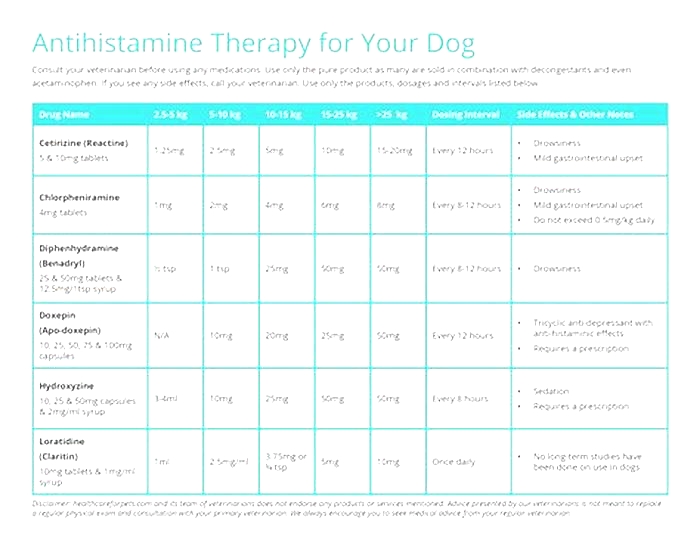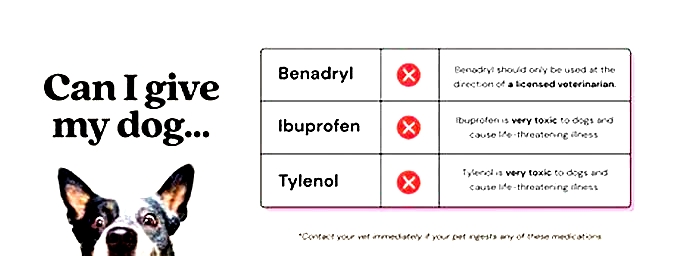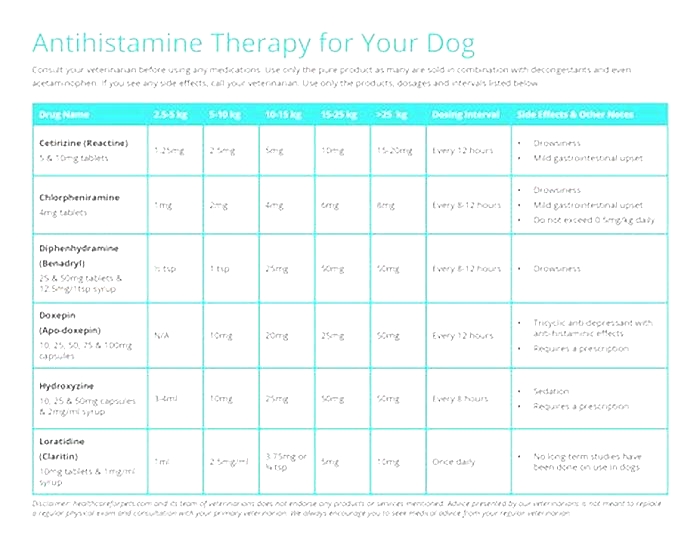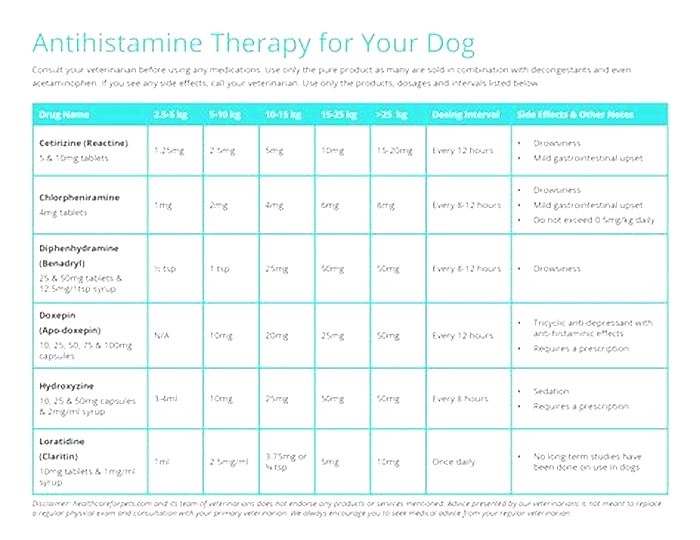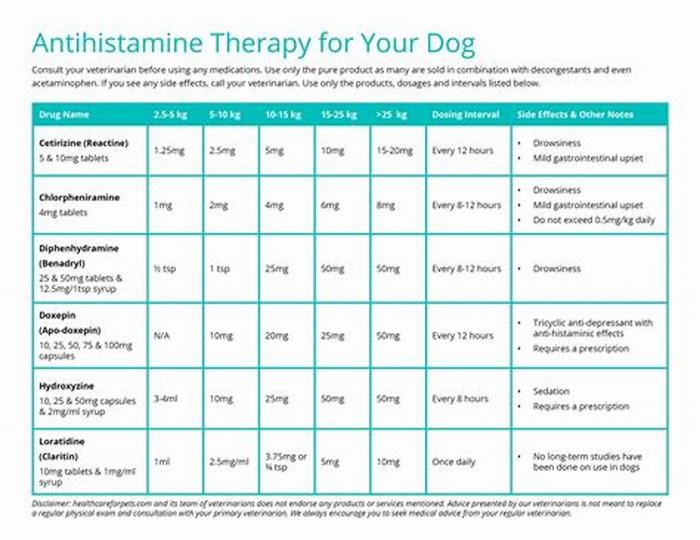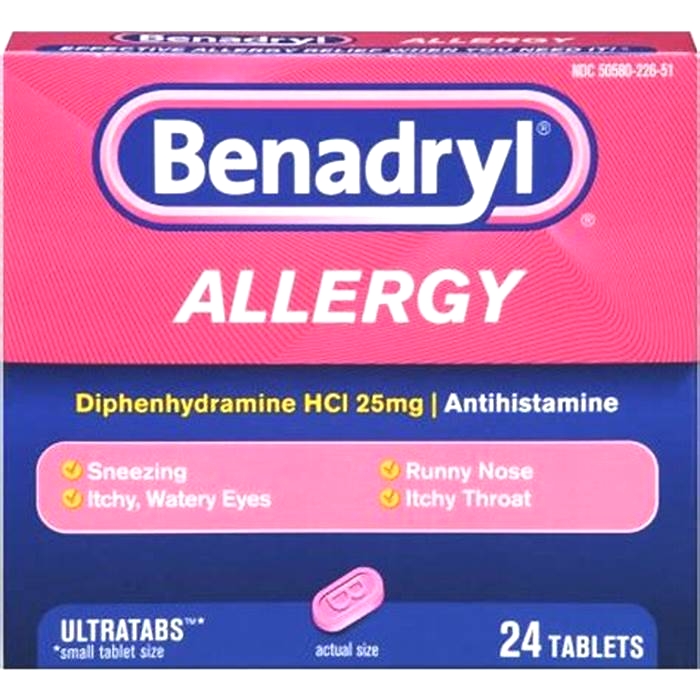How many times a day can I give my dog antihistamine
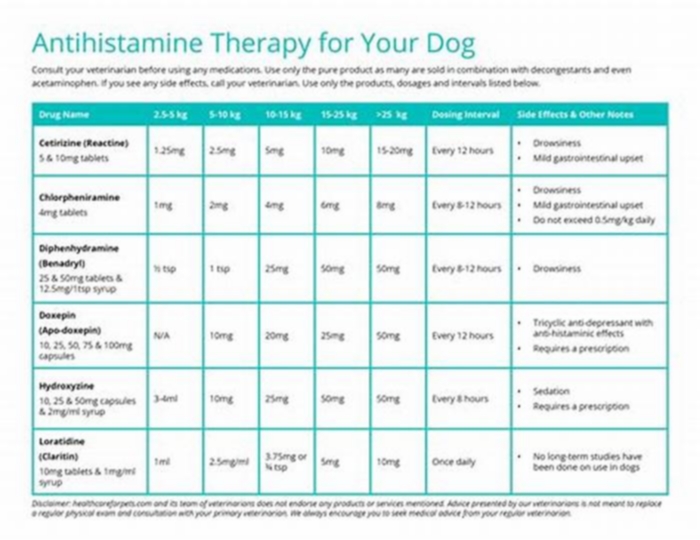
How Much Benadryl Can I Give My Dog? Is it Safe?
Are you wondering whether you can give your dog Benadryl to help with itching, allergies, or anxiety?
Benadryl (Diphenhydramine) is generally safe for most dogs when used correctly. However, before administering this medication to your furry friend, it's crucial to know the recommended dosage based on your dog's weight.
This article will serve as a comprehensive guide for how much Benadryl you can give your dog, how to calculate the proper dosage, and the potential side effects to keep an eye on.
Note: Please remember to consult a veterinarian before administering Benadryl or any other medication to your pet.
Is Benadryl Safe for Dogs?
As a licensed veterinarian, I would say Benadryl is safe for dogs when given at the appropriate dosage. It is an antihistamine that can help alleviate symptoms of allergies, such as itching, swelling, and sneezing.
However, dogs with certain medical conditions may not be good candidates for Benadryl and should only be given the medicine under the guidance of a veterinarian.
Types of Benadryl
Diphenhydraminecomes in various forms, including tablets, capsules, and liquid. Each has its own level of strength in milligrams (mg).
Benadryl is available in:
Tablets- small round tables that come in 25mg or 50mg strength.
Capsules- small capsules that also come in 25mg or 50mg strength.
Liquid- similar to other liquid medications and following a mg/mL dosing, these typically come in a strength of 12.5mg/5ml (2.5mg/ml). If you choose the liquid form, make sure that it does not contain xylitol or other active ingredients.
How Much Benadryl is Recommended for Dogs?
The general guideline for Benadryl dosage is quite straightforward:1 mg of Benadryl per pound of body weight, administered every 8 to 12 hours. This frequency helps maintain the medication's effectiveness throughout the day.
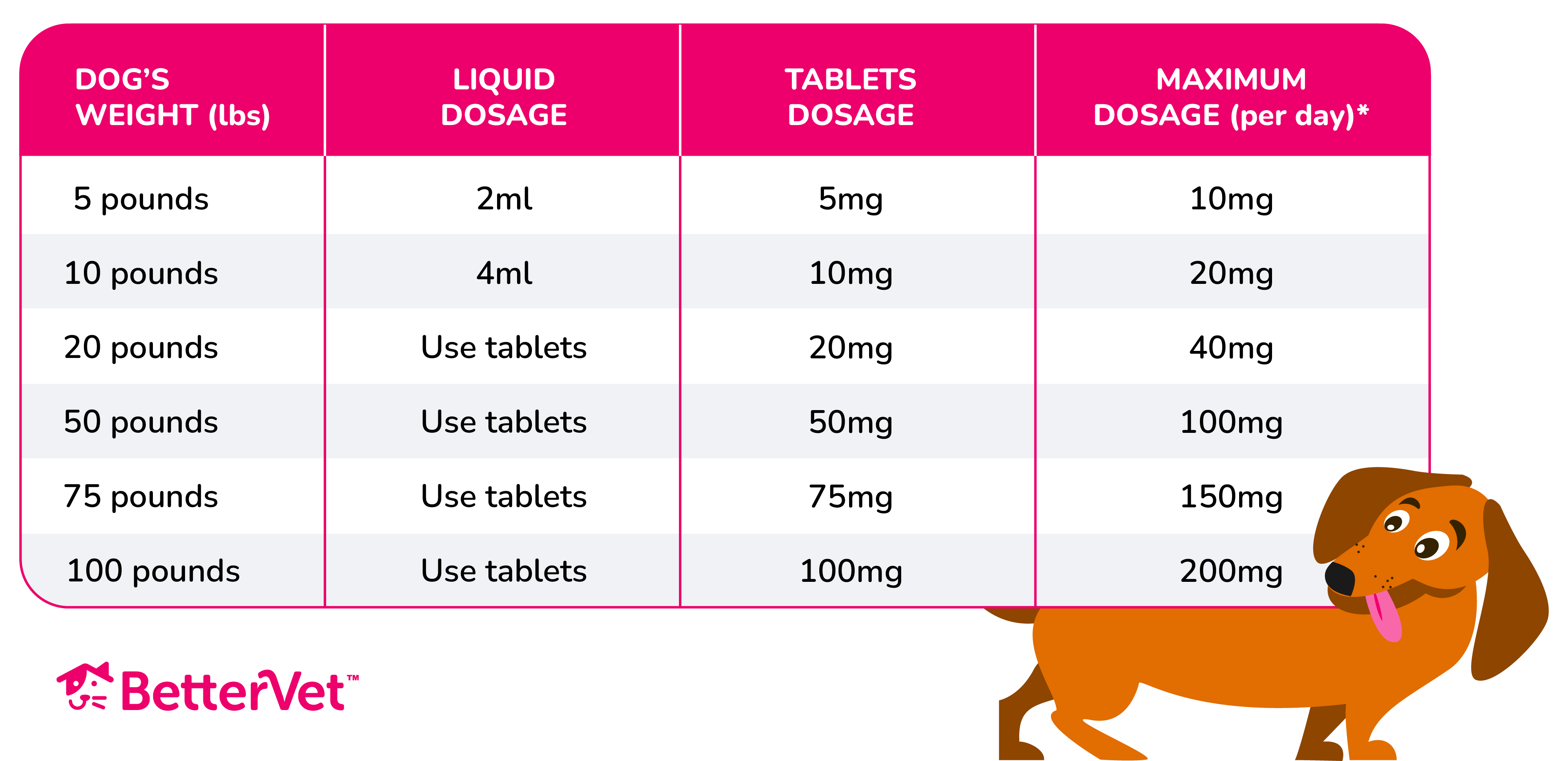
Liquid Benadryl is typically recommended for dogs weighing less than 10 pounds, as this can make it easier to achieve an accurate and appropriate dose.
For dogs weighing more than 10 pounds, most veterinarians recommend tablets, which come in 25-50 mg sizes. Achieving the appropriate dose requires breaking the tablets into quarters as closely as possible. However, it is important to note that the exact dosing will depend on your dog's individual needs and medical history.
Liquid Benadryl Dosage Formula for Dogs
If you need to calculate the appropriate liquid dosage of Benadryl for your dog, you can use a simple formula. First, divide your dog's weight in pounds by 2.5. The result will give you the appropriate dose in milliliters (ml).
For example, if your dog weighs 10 pounds, you would calculate its dosage as follows: 10lbs 2.5 = 4ml.
Once you have determined the appropriate dosage, you can measure it using a syringe or a measuring spoon. It is important to note that one teaspoon is equal to 5 ml, so if your dog requires a dose of more than one teaspoon, you will need to use multiple teaspoons to measure the appropriate amount.
Dog Benadryl Dosage by Weight Chart
Below is a table illustrating how much Benadryl you can give your dog depending on how much it weighs.
Dog Weight (lbs) | Liquid Dosage (mL)* | Tablet Dosage (mg) | Total Daily Dosage (mg) |
5 | 2 mL | 5 mg | 10 mg |
10 | 4 mL | 10 mg | 20 mg |
15 | 6 mL | 15 mg | 30 mg |
20 | 8 mL | 20 mg | 40 mg |
25 | 10 mL | 25 mg | 50 mg |
30 | 12 mL | 30 mg | 60 mg |
35 | 14 mL | 35 mg | 70 mg |
40 | 16 mL | 40 mg | 80 mg |
45 | 18 mL | 45 mg | 90 mg |
50 | 20 mL | 50 mg | 100 mg |
55 | 22 mL | 55 mg | 110 mg |
60 | 24 mL | 60 mg | 120 mg |
65 | 26 mL | 65 mg | 130 mg |
70 | 28 mL | 70 mg | 140 mg |
75 | 30 mL | 75 mg | 150 mg |
*Assuming a liquid concentration of 12.5mg/5mL, which is a common formulation.
Can You Use Benadryl to Treat Allergies in Dogs?
Yes, Benadryl is effective for treating a range of allergy symptoms in dogs. Whether it'sseasonal allergiesor reactions to an environmental irritant, Benadryl can offer quick relief, making it a go-to in my practice for immediate symptom management.
Here are the allergy symptoms Benadryl can help treat in dogs:
Sneezing: Reduces sneezing caused by environmental allergens.
Reverse Sneezing: Can alleviate episodes of reverse sneezing, which are often benign but can be triggered by irritants or allergens.
Red Eyes: Helps soothe red, irritated eyes resulting from allergic reactions.
Watery Eyes: Reduces excessive tear production associated with allergies.
Itching: Eases skin itchiness due to allergies, helping to prevent scratching that can lead to skin infections.
Hives: Reduces the occurrence of hives secondary to an allergic reaction.
Skin Allergies: Offers relief from discomfort caused by allergic dermatitis and other skin allergies.
Seasonal Allergies: Mitigates symptoms associated with seasonal allergies, such as pollen.
If you are unsure if Benadryl is the right medication to treat your dogs allergy-related symptoms,schedule a virtual vet visitwith one of our online veterinarians.
What Else Can You Use Benadryl for in Dogs?
In addition to its use in managing allergy symptoms, Benadryl can have a range of other applications when used in dogs.
Some use cases of Benadryl in dogs may include:
It is also worth noting that while Benadryl can be an effective tool in managing specific health issues in dogs, it may not be appropriate for every situation, and other treatments or interventions may be necessary.
Common Side Effects of Benadryl in Dogs
When administering Benadryl, themost frequently observed side effect is drowsiness. This is due to thesedative properties of diphenhydramine, the active ingredient in Benadryl.
While this can be beneficial in calming allergic reactions, it's important to monitor your pet to ensure they are comfortably resting and not overly sedated.
When giving your dog Benadryl, watch for these side effects:
Drowsiness: The most common effect, due to Benadryl's sedating properties.
Dry Mouth: Increased thirst and frequent water seeking are signs to look out for.
Nausea and Vomiting: Less common, but some dogs may become nauseous.
Increased Heart Rate: A serious side effect that requires immediate veterinary attention.
Rapid Breathing: Another critical sign indicating the medication may not be well-tolerated.
Urinary Retention: Difficulty urinating, a less common but important side effect to monitor.
Can a Dog Overdose on Benadryl?
Yes, a dog can indeed overdose on Benadryl. Overdosing can lead to severe health complications. It's crucial to adhere strictly to the recommended dosage guidelines and consult with your veterinarian to prevent such a situation.
Here are thesigns of a Benadryl overdose in dogsthat you should be aware of:
Rapid Heartbeat: An increase in heart rate beyond the normal range.
Dilated Pupils: Noticeable enlargement of the pupils.
Agitation or Hyperactivity: Uncharacteristic restlessness or increased activity.
Constipation: A noticeable decrease in or absence of bowel movements.
Seizures:Convulsions or severe twitching, which are medical emergencies.
Dry Mouth: Significantly reduced saliva production or extreme thirst.
Urinary Retention: Difficulty urinating or an inability to urinate.
If you observe any of these signs in your dog after administering Benadryl, it's imperative toseek emergency veterinary care immediately.
An overdose requires prompt medical attention to mitigate the risks and ensure your pet's safety and well-being.
Conclusion
In summary, Benadryl (diphenhydramine) can be a helpful and safe medication for treating mild itching, to be used as a mild sedative, and to prevent acute allergic reactions in dogs.
Common side effects of Benadryl in dogs include sleepiness and gastrointestinal symptoms but most dogs will tolerate the medication well.
If you have concerns about giving Benadryl to your dog or if your dog experiences any adverse effects, consult with your veterinarian.
Frequently Asked Questions
How long does Benadryl last in dogs?
Benadryl typically lasts 6-8 hours in dogs. However, the actual duration of effect may vary depending on factors such as your dog's weight, age, and health status.
How long does it take for Benadryl to work on dogs?
Benadryl typically takes effect within 30 minutes to an hour of administration. However, this time may vary depending on your dog's weight, age, and health status.
Can dogs be allergic to Benadryl?
Yes, dogs can be allergic to Benadryl or any other medication. While it is generally well-tolerated, some dogs may experience allergic reactions to Benadryl, such as itching, hives, swelling, or difficulty breathing.
Can I give my dog Benadryl?
Benadryl is commonly used in dogs with mild-to-moderate allergies. It can help relieve symptoms like itching, sneezing, and watery eyes. However, it's important to talk to your vet before giving your dog Benadryl, as it can interact with other medications or health conditions.
The recommended dosage to administer the medication is typically 0.9 to 1.8 milligrams per pound of your dog's body weight, given 1-2 times per day. Always use the appropriate formulation and dosage for your pet's size and weight, and follow your vet's instructions carefully.
Can I give my dog Benadryl for itching?
Yes, you can give your dog Benadryl for itching. Benadryl contains an antihistamine called diphenhydramine, which can help alleviate itching in dogs.
Can I give my dog human Benadryl?
Yes. Benadryl is an over-the-counter medication that is labeled for humans but is generally considered safe for dogs in the appropriate dosage. Always consult with your veterinarian before giving your dog any medication.
Can I give my dog Benadryl every day?
It is generally safe to give your dog Benadryl daily for short periods, as directed by your veterinarian. However, if you plan to give your dog Benadryl for longer than a few days, you should consult your vet to discuss potential risks or concerns.
Can I use Benadryl to sedate my dog for travel?
While Benadryl may have a mild sedative effect on some dogs, veterinarians typically do not recommend it as a primary sedation method for travel. Instead, discussing options for safe and effective sedation with your veterinarian would be best.
How much Benadryl to give a 50 LB dog?
It is generally recommended to provide two 25-milligram tablets, but it's crucial to consult with a veterinarian beforehand to ensure that Benadryl is suitable for your dog's specific requirements and to verify the correct dosage based on your dog's weight and other health considerations.
Read more: 10 Tips for Traveling with Your Pet
Sources and References
Worth, A.C., Wismer, T.A. and Dorman, D.C., 2016. Diphenhydramine exposure in dogs: 621 cases (20082013). Journal of the American Veterinary Medical Association, 249(1), pp.77-82.
Loew, E.R., MacMILLAN, R.O.B.E.R.T. and Kaiser, M.E., 1946. The anti-histamine properties of Benadryl, -dimethylaminoethyl benzhydryl ether hydrochloride. Journal of Pharmacology and Experimental Therapeutics, 86(3), pp.229-238.
Cortinovis, C., Pizzo, F. and Caloni, F., 2015. Poisoning of dogs and cats by drugs intended for human use. The Veterinary Journal, 203(1), pp.52-58.
Are Antihistamines For Dogs Safe?
NOTE: You should always contact your veterinarian for advice and guidance before giving a pet any over the counter medication
No dog owner likes to see their pup sneezing, coughing and irritated due to an allergy. Yet finding a solution to the problem seems to be a lot harder than it should be.
Effective, safe and dog-specific allergy medicines seem to be annoyingly difficult to get your hands on (although they do exist), and so its only natural that dog owners have begun to question whether our own human antihistamines could help alleviate the symptoms of a struggling four-legged friend.
From Benadryl to Piriton, this article will explore the pros and cons of giving your dog human antihistamines, helping you to put a stop to your animals agitation!
Can I give my dog human antihistamines?
Human antihistamines are usually safe for dogs to take, but make sure you check the brand and correct dosage amount with your vet before giving one to your pet.
The most commonly used antihistamines are diphenhydramine, cetirizine and loratadine, which can all help relieve symptoms such as itching and sneezing for dogs.

Although sounding decidedly scientific, you may know these better as the main ingredients in well known branded allergy drugs such as Benadryl (diphenhydramine), Claritin (loratadine) and Zyrtec (cetirizine).
Just like with humans, these antihistamines can sometimes have side effects on dogs and so you need to be wary. Thankfully these arent usually harmful and tend to result in either making a dog very drowsy or opposingly making them behave more hyperactive or erratically.
But although most brands are generally safe, you do need to be careful when shopping for over the counter antihistamines. Occasionally they will contain other harmful ingredients such as decongestants which could be toxic for your dog.
Such mistakes can be avoided by thoroughly observing the label and ingredients list, or by getting in touch with your vet!
Best antihistamine for dogs
The best antihistamine for dogs is the Vets Best Seasonal Allergy Tablet, purely because its one of the only antihistamines on the market to be made especially for canines and not humans.
In fact, its not even suitable for human consumption!
This means you no longer have to stress over whether you can give your pooch a Piriton or not, as theres already a doggy designed option readily available!
While most canine allergy relief products are merely a vitamin or fatty acid supplement designed to boost itchy skin, Vet Bests tablets are one of the few to contain an actual antihistamine that prevents your pups body from reacting to allergens and stimuli they are sensitive to.
The tablets utilise the active ingredient diphenhydramine hydrochloride, the same antihistamine used in popular human allergy tablets such as Benadryl. And unlike other dog allergy medicines like Apoquel, Vets Best doesnt require a prescription, making them a cheaper and less time-consuming, quick fix!
The tablets work in the same way as a human drug, by blocking the bodys H-1 receptors in the blood vessels and muscles. This prevents your dogs body from producing histamines when confronted with non-harmful allergens, and in turn prevents irritating reactions like itching, sneezing, watery eyes and a runny nose.

Anyone who owns an allergy-suffering pup knows that skin issues are often the most troublesome symptom. So Vets Best tablets are a particular lifesaver when it comes to providing fast relief to minor skin irritations, helping to reduce constant scratching.
As the tablet is designed for dogs, working out the right dosage for your pet pooch is also totally hassle-free. Here is the simple dosage table for you to follow, based entirely on your pups weight!
- 10-24 lbs: 1/2 tablet
- 25-49 lbs: 1 tablet
- 50-75 lbs: 1 1/2 tablets
- 75 lbs+: 2 tablets
As with any medicines, you should always check with your vet before administering Vets Best to your pet, just to be safe.
Ask a veterinarian before use if your pet has:
- Glaucoma
- Asthma
- Heart Disease
- Hypertension
- Urinary Bladder Obstruction
- Enlarged Prostate Gland
- Hyperthyroidism
- Is Pregnant or Nursing
- Weighs under 15 lbs
Its also particularly important to avoid using it in combination with any other product which contains diphenhydramine, to help avoid overdose
Can I give my dog Benadryl?
Although it might seem strange, it is usually safe to give your dog Benadryl to relieve allergy symptoms, and its even prescribed or recommended by some vets.
However, like with any drug, it may not particularly be the best solution to your pups problem!
Benadryl has been known to have adverse effects when taken in combination with other medications your dog may be on, which is why its always imperative to talk to your vet before administering it.
How and when to use Benadryl for dog allergies
Benadryl is best for dogs who are suffering from low to mild allergic symptoms because the drug isnt specifically formulated for canines, so their effectiveness can range from mild to effective.

However, vets still often use it to ease environmental allergies in pups and also to deal with reactions to insect bites or stings. It can also be used as a pre-treatment for possible vaccine reactions.
It is to be taken orally, so it is often easiest to add a pill to your dogs food.
Benadryl is not a suitable medication if your pet is having an acute allergic reaction.
Symptoms of an acute reaction are characterised by facial swellings, difficulty breathing and in rare cases anaphylactic shock.
When to avoid Benadryl
Benadryl is one of the safest over-the-counter drugs that can double up as a doggy medication.
However, for canines with certain health issues, they are not the smartest choice.
For pregnant dogs, dogs with glaucoma and canines with low blood pressure or cardiac conditions, taking Benadryl is an unneeded safety risk and so its best to avoid using it.
And its also important to note that if you make the wrong choice, they can be a risk for healthy dogs too. Thats because some Benadryl tablets are combined with other medicines which make them unsuitable and so its vital you ensure your Benadryl tablets contain only diphenhydramine.
Whats the correct Benadryl dosage for a dog?
The recommended dosage of Benadryl for a dog is 1 mg per pound of body weight, to be taken 2-3 times a day. Standard tablets are 25 mg, and so they are the perfect size for a 25 lbs dog.
Obviously this gets trickier when your pup is slightly larger or smaller than 25 lbs and so the most reliable thing to do is ask your veterinarian for the correct dosage for your canine.
Can I give my dog Piriton?
It is generally considered safe to give a dog Piriton to treat environmental allergies, as long as you have sought guidance from a veterinary professional first.
Unlike some of the previously mentioned antihistamines, Piriton is mainly made up of the ingredient chlorphenamine. In the human world, this drug is mainly used to treat runny, itchy noses and hive symptoms, making it a great anti-allergy tablet.
However similar to Benadryl, it is often prescribed by vets to help treat dogs suffering allergic reactions.
But as with Benadryl, if using Piriton for a pup, you should be wary of there being a chance of side effects.
In Piriton these can include; drowsiness, constipation, dry mouth and nausea. In rare instances, these can be more severe and may include respiratory issues, irritability, poor coordination, urination issues and affected concentration.
Thankfully, all of these reactions tend to be fairly mild if they actually occur.
When to avoid Piriton for dogs
If your dog has an existing medical condition, it isnt worth taking the risk and giving them Piriton without the advice of a vet.
Whats the correct Piriton dosage for a dog?
Typically, vets recommend dosing by the dogs weight at 0.91.7 mg per pound of body weight, every 8 to 12 hours.
Its important to remember though that this is merely a guideline, and as always, the best way to determine the correct dosage for your dog is to contact your vet.


